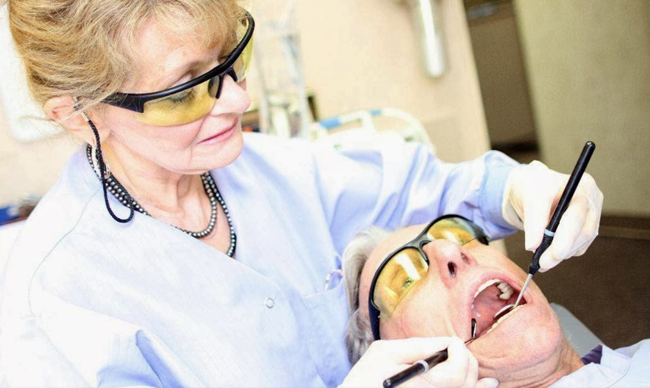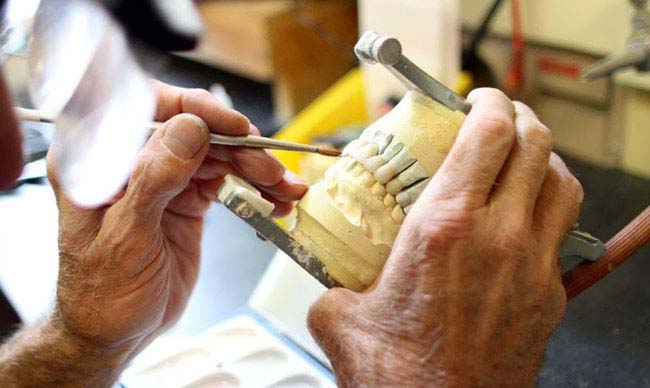Our Services

Dr. Anne Magner is performing a routine examination.
From a routine exam and cleaning to full-mouth rehabilitation, our practice is equipped to handle all of your dental needs. To help you understand more about our office, we have included brief descriptions of some of our most common services on this page.
Initial Oral Examination
Your first visit at our office is very important in establishing your oral health baseline. We will perform a complete oral examination which includes an oral cancer screening, periodontal evaluation, an analysis of your occlusion (bite) and a thorough examination of your teeth, their supporting structures and of the oral anatomy.
Cosmetic
Crowns & Caps
The terms dental crowns and caps are synonymous. Crowns are typically used to restore a tooth's function and appearance following a restorative procedure such as a root canal. When decay in a tooth has become so advanced that large portions of the tooth must be removed, crowns are often used to restore the tooth. Crowns are also used to attach bridges, cover implants, or to prevent a cracked tooth from becoming worse. Crowns also serve an aesthetic use, and are applied when a discolored or stained tooth needs to be restored to its natural appearance. Crowns are fabricated in a laboratory and are made either of porcelain baked onto a metal substrate, all-porcelain, or many of the new ceramic materials that have been developed.
Bridges & Dentures
A bridge may be used to replace missing teeth, help maintain the shape of your face, and alleviate stress on your bite. A bridge replaces missing teeth with artificial teeth, looks great, and literally bridges the gap where one or more teeth may have been. Your bridge can be made from gold, alloys, porcelain, or a combination of these materials and is bonded onto surrounding teeth for support. There are two basic types of bridges. A fixed bridge which remains in your mouth at all times and is supported by your natural teeth. Removable bridges (partials and full dentures) are removed from the mouth several times a day for cleaning and rest on the gum where the missing teeth are being replaced.
Veneers
Gaps, chips, stains, or misshapen teeth can now be treated with wonderful results and very conservatively using porcelain veneers. Veneers are natural in appearance, and are a perfect alternative for patients wanting to make minor adjustments to the look and feel of their smile. Veneers are thin, custom-made shells made from tooth-colored materials (such as porcelain) designed to cover the front side of your teeth.
Teeth Whitening
Our in-office state-of-the-art bleaching system will make your teeth whiter and brighter. You may also use our take home bleaching system to achieve a brighter and whiter smile in a matter of days.
Invisalign®
Invisalign®* is a form of orthodontic treatment that works to correct many different types of malocclusions through the use of a series of clear plastic trays called aligners. In many cases it provides an excellent treatment alternative to traditional orthodontic braces and metal wires.
Invisalign utilizes 3-D computer imaging technology to correct problematic bites or malocclusions by planning a complete sequence of custom-made clear aligners. This series of clear aligners, each of which is worn for a couple of weeks, incrementally move the teeth into place until the final desired corrections are reached.
The advantage and appeal of Invisalign appliances is that they are more cosmetic and more comfortable than most other orthodontic appliances. With Invisalign appliances orthodontic treatment is practically "invisible."
*Invisalign is a registered trademark of Align Technology, Inc.
Dental Implants

Implant Dentistry
If a tooth is extracted or missing for some other reason, it is now possible to replace it using dental implants. An implant is a new tooth made of metal and porcelain that looks just like your natural tooth. It's composed of two main parts: One part is the titanium implant body that takes the place of the missing root, and the second part is the tooth-colored crown that is cemented on top of the implant. In addition to tooth replacement, implants may be used to anchor dentures, especially lower dentures that tend to shift when you talk or chew. For patients with removable partial dentures, implants can replace missing teeth so that you have a more natural-looking smile.
TEETH-IN-A-DAY™
The “Teeth in a Day” solution is attractive to patients wanting to get rid of their dentures or need to have their severely failing teeth replaced by a new full arch of teeth. This procedure “Teeth in a Day”, as the name implies, requires less than a days worth of work to fully customize a set of replacement teeth. The entire treatment is completed within a few hours and can be done while the patient is comfortably asleep using sedation dentistry. The best part is that the procedure is painless and patients receive their full set of replacement teeth the same day.
Traditional approaches to restoring a full arch of teeth may require as many as 18 months of treatment. That means that a patient often would be without teeth or with ill-fitting temporary dentures for more than a year. With the Teeth in a Day solution, the patient has one or two visits to our office to gather information for a treatment plan. Following this consultation, the patient is scheduled for implant placement and the new teeth are fitted and adjusted within 24 hours (even when extractions are necessary).
The patient will return for occasional check-ups over the next several weeks and months. After almost six months, when the gums have fully healed and the implants are fused to the natural bone, we will take new impressions of the patient’s mouth and prepare a final, stronger, permanent set of teeth adjusted to a perfect fit. This helps ensure the longest life of the teeth, and provide maximum support, beauty, and function to the patient.
TMJ
The Prevalence of Temporomandibular Joint Problems
According to the National Institute of Dental and Craniofacial Research (NIDCR), temporomandibular joint disorders (TMJ), also referred to as temporomandibular disorders (TMD), are the most common source of chronic facial pain and jaw dysfunction. It is estimated that more than 10 million people in the United States are affected by temporomandibular joint problems.
What is the Temporomandibular Joint?
Two temporomandibular joints connect the left and right sides of the lower jaw to the temporal bone. Both joints and their associated muscles, ligaments, and tendons work together to allow for all manner of oral function as the jaw moves up and down, front to back and from side to side. Containing a shock-absorbing, soft disc that sits between the rounded condyles of both sides of the lower jaw and the corresponding concavities in the skull’s temporal bone, the TMJ makes chewing, speaking, yawning and all jaw movements possible.
Since the TMJ is a joint with both up and down hinge-like movements, as well as side to side and front to back sliding motions to perform, it is often considered one of the most complicated joints in the body and one of the most difficult to treat when problems arise.
Types and Symptoms of TMJ Disorders
TMJ disorders can fall into one or more of the following three categories:
- Myofascial pain- Refers to pain in the area of the jaw joint due to various causes of increased muscle tension and spasm
- Internal derangement-Involves displacement of the disc, jaw dislocation or trauma to the condyles of the jaw
- Degenerative joint disease -Arthritis
The risk of developing a TMJ problem is higher in the presence of long-term teeth grinding or bruxism, a jaw injury or various types of arthritis such as rheumatoid arthritis and osteoarthritis. Furthermore, the manifestations of a TMJ disorder can vary from person to person with a wide range of symptoms possible, including earaches, ringing in the ears (tinnitus), headaches, back and neck pain, vertigo, muscle spasms, and joint tenderness as well as jaw pain, popping or grating sounds with jaw movement, jaw locking and limited jaw movement. For some people, a TMJ disorder can be resolved within a relatively short period, while for others it will continue to persist despite extensive therapy.
Diagnosis and Treatment
When evaluating for the presence of a TMJ disorder, an oral and maxillofacial surgeon will perform a thorough clinical assessment of joint symptoms and function. Special radiographic imaging and other diagnostic tests will be ordered as needed. The treatment of a TMJ disorder may include oral appliances such as night guards or stabilization splints to alleviate strain on the joints. Other types of therapy may include steroid injections, occlusal adjustments as well as orthodontic or prosthodontic treatment to improve occlusion. In cases of severe and persistent TMJ problems, the oral and maxillofacial surgeon may recommend a surgical procedure.
Methods of self-care can be helpful in alleviating some of the symptoms of a TMJ disorder. Patients are typically advised to eat soft foods, avoid extreme jaw movements such as wide yawning and gum chewing, to practice stress reduction and relaxation techniques and to apply ice packs or moist heat as directed. As recommended, a patient should follow the oral and maxillofacial surgeon's or therapist’s instructions for gentle stretching exercises. The short-term use of over-the-counter, non-steroidal, anti-inflammatory drugs and pain medications may provide relief. If not, stronger pain or anti-inflammatory drugs, muscle relaxants or anti-depressants may be prescribed

